
Autumn in Japan is often associated with the beauty of autumn foliage, but in the Kanto region, seasonal flowers such as autumn roses, cosmos, and red spider lilies (higanbana) are also not to be missed. Their vibrant colors offer a delightful way to experience the changing seasons.
In this guide, we have carefully selected parks and gardens in the Tokyo area where you can enjoy these autumn blooms. Among them, Hitachi Seaside Park in Ibaraki Prefecture is especially breathtaking, with vast fields of bright red kochia and delicate cosmos creating a scenery so picturesque it feels like a painting. Each of these spots is perfect for an autumn stroll, so consider adding them to your seasonal outings.
Note: Peak viewing times may vary each year.
(This page may contain promotions)
- Table of Contents
-
- 1. Hibiya Park: Autumn Roses and Cosmos Adorning an Oasis in the Business District
- 2. Shinjuku Gyoen National Garden: A Sea of 500 Roses from about 110 Species
- 3. Kinuta Park: Over 200 Roses, Pastel and Vivid
- 4. Kyu-Furukawa Gardens: Scenery from a Fairy-tale
- 5. Jindai Botanical Gardens: One of Tokyo's Most Beloved Flower Viewing Spots
- 6. Hitachi Seaside Park: A Contest Between Kochia and Cosmos
- 7. Hama-rikyu Gardens: Enjoy an Urban Autumn Scene Where Skyscrapers and Cosmos Coexist
- 9. Nasu Flower World: Enjoy Autumn Flower Fields with Views of the Nasu Mountain Range
- 10. Ashikaga Flower Park: Savor an Autumn Woven with Flowers and Light
- 11. Kinchakuda Manjushage Park: Enjoy a Spectacular Spider Lily Display
- 12. Yachiyo City’s Murakami Green Space Park: Beautiful Spider Lillies on Display
1. Hibiya Park: Autumn Roses and Cosmos Adorning an Oasis in the Business District

The spacious Hibiya Park was opened in 1903 as Japan's very first modern, Western-style park. Bordering on both Ginza and Kasumigaseki, it has become an oasis of relaxation in the middle of the busy business districts.
The first and second flowerbeds are dedicated to roses and are a beautiful sight, particularly in autumn. Around 500 kinds of different roses are planted throughout the park, such as the "Dancing Girl of Izu" tribute rose shining in a vivid yellow, as well as the bright red "Mister Lincoln" rose. Pink, orange, and other vivid roses dot the entire park.

Cosmos flowers can also be found in the First Flower Bed, offering visitors the chance to enjoy their charming combination with the autumn roses.
- Best Time to See Autumn Roses: October–November
- Best Time to See Cosmos: Mid-October–Early November
- Admission Fee: Free (Some facilities require a fee)
- Hours: Open Daily
- Official Website
-

-
Address
1-6, Hibiyakouen, Chiyoda-ku, Tokyo, 100-0012
View Map -
Nearest Station
Hibiya Station (Tokyo Metro Hibiya Line / Tokyo Metro Chiyoda Line / Toei Mita Line)
3 minutes on foot
- Phone Number 03-3501-6428
-
Address
1-6, Hibiyakouen, Chiyoda-ku, Tokyo, 100-0012
2. Shinjuku Gyoen National Garden: A Sea of 500 Roses from about 110 Species

Shinjuku Gyoen National Garden, opened in 1906, encompasses a vast space of around 583,000 square meters and is divided into three areas: the French Garden, The English Garden, and the Japanese Garden featuring a pond to stroll around.
For stunningly beautiful autumn flowers, the French Garden is the place to go. Around 500 individual flowers from 100 species of roses bloom in the entire area, making for a gorgeous sea of roses. Among them are especially popular blossoms such as Double Delight or Freesia.

The magnificent autumn roses bloom in the formal garden. Around 500 rose bushes of approximately 110 varieties compete in beauty, creating a splendid display. Popular varieties include Double Delight and Freesia.

Red spider lilies can be found near the shrubbery by Tamamo Pond, in the Japanese garden, in the shrubbery near the management office, and in the Mother and Child Forest.
(*Alcoholic drinks and play equipment (such as balls or toys) are forbidden within the garden.)
- Autumn Roses: October–November
- Red Spider Lilies: Mid-September–Late September
- Admission Fee: Adults: 500 yen, Ages 65 and Over: 250 yen, Students (High School Students and Up): 250 yen, Children (Middle School Students and Up): Free
- Hours:
October 1–March 14: 9 AM - 4 PM (Closes at 4:30 PM)
March 15–June 30, August 21–September 30: 9 AM - 5:30 PM (Closes at 6 PM)
July 1–August 20: 9 AM - 6:30 PM (Closes at 7 PM) - Closed: Every Monday (or the following weekday if Monday is a holiday), New Year's Holidays (December 29–January 3)
- Official Website
-

-
Address
11 Naito-cho, Shinjuku-ku, Tokyo, 160-0014
View Map -
Nearest Station
Shinjuku-Gyoemmae Station (Tokyo Metro Marunouchi Line)
5 minutes on foot
- Phone Number 03-3350-0151
-
Address
11 Naito-cho, Shinjuku-ku, Tokyo, 160-0014
3. Kinuta Park: Over 200 Roses, Pastel and Vivid

Setagaya's Kinuta Park spreads over roughly 400,000 square meters and features a large open-spaced lawn, a bird sanctuary, an art museum, and many other facilities. On the eastern side of the athletic plaza is also a beautiful rose garden, home to around 290 roses of 27 different species, such as Princess Aiko blossoming in a lovely pink or the calm Blue Bayou.
Mid-October is the best time to visit as the flowers are in full bloom during that time, and around that time, a rose guidance tour is offered on a Saturday and Sunday. Why not learn more about the park's beautiful roses while enjoying the magnificent sight? The rose garden is usually not accessible so this is really a rare and unique opportunity.

From summer to autumn, golden cosmos bloom spectacularly near the observation windows of the bird sanctuary on the park’s west side, delighting visitors with their vibrant color.
- Best time to see autumn roses: Mid-October to Mid-November
- Best time to see yellow cosmos: August to September
- Admission: Free (some facilities require a fee)
- Hours: Open daily
- Official website
-

-
Address
1-1, Kinutakouen, Setagaya-ku, Tokyo, 157-0075
View Map -
Nearest Station
Yoga Station (Tokyu Den-en-toshi Line)
-
Address
1-1, Kinutakouen, Setagaya-ku, Tokyo, 157-0075
4. Kyu-Furukawa Gardens: Scenery from a Fairy-tale

Western-style buildings that seem to have sprung right out of a fairy-tale stand on a small hill of the Musashino Plateau - this beautiful scenery is the Kyu-Furukawa Gardens. In the past, this stunning place served as the residence of Mutsumune Mitsu, a Foreign Minister during the Meiji era. A Western-style garden graces the slopes of the hill while a beautiful Japanese garden spreads over the lowland.
Around the mansion blossom all kinds of different roses such as First Love, Princess Michiko, and Inca - 199 roses of one-hundred different species.
Every year in mid-October, various events are taking place, such as the "Autumn Rose Festival" or the "Autumn Rose Concert."

By November, the Japanese garden’s maple trees blaze with vivid autumn colors, bathing the entire grounds in a rich seasonal palette. Here, visitors can experience a truly unique autumn scene where the elegance of Japanese tradition meets the splendor of the West.
- Best time to see autumn roses: Mid-October to late November
- Best time to see autumn leaves: Mid-November to early December
- Admission Fee: Adults: 150 yen, Ages 65 and over: 70 yen (Free for elementary school students and younger, and junior high school students living or studying in Tokyo)
- *A separate admission fee applies to the Western-style building.
- Official Website
-

-
Address
1-27-39, Nishigahara, Kita-ku, Tokyo, 114-0024
View Map -
Nearest Station
Kami-Nakazato Station (JR Keihin-Tohoku Line)
7 minutes on foot
- Phone Number 03-3910-0394
-
Address
1-27-39, Nishigahara, Kita-ku, Tokyo, 114-0024
5. Jindai Botanical Gardens: One of Tokyo's Most Beloved Flower Viewing Spots

Originally, the Jindai Botanical Gardens were a nursery for trees that were supposed to line Tokyo's many streets but in 1961, it was reopened as the metropolitan area's only botanical garden. The place is actually one of Kanto's most famous and popular rose gardens and was even awarded the WFRS Award of Garden Excellence in 2009.
Inside the symmetrical sunken garden, you'll find a total of 5,000 individual roses from about 300 different species, letting the garden shine in all variations of colors, vivid and pale alike. The best period to see the flowers in full bloom is mid-October and during that time, the entire garden is beautifully lit up and various events and guided tours are being held throughout the entire month of October.

The dahlia garden is equally captivating, showcasing a stunning array of blooms from large, dramatic flowers to delicate, small blossoms.

Visitors can also enjoy the seasonal beauty of chrysanthemums, presented in traditional Japanese styles such as kengai (cascade) and bonsai arrangements—testaments to the skill of master horticulturists.
During the peak blooming period, the gardens attract throngs of photography enthusiasts and flower lovers alike. Jindai Botanical Gardens offers a rich natural setting where visitors can fully savor the beauty of autumn.
- Best time to see autumn roses: October–November
- Best time to see dahlias: Late September–October
- Best time to see chrysanthemums: Late October–Early November
- Admission Fee:
Adults: 500 yen
65 and Over: 250 yen
Middle School Students: 200 yen (Free for junior high school students enrolled in or residing in Tokyo)
Elementary School Students and Younger: Free - Hours: 9:30 AM–5 PM (Entry until 4 PM)
- Closed: Mondays (or the following day if a holiday falls on a Monday), New Year's Holidays (12/29–1/1)
- Official Website
-

-
Address
5-31-10, Jindaijimotomachi, Chofu-shi, Tokyo, 182-0017
View Map -
Nearest Station
Chofu Station (Keio Line / Keio Sagamihara Line)
- Phone Number 042-483-2300
-
Address
5-31-10, Jindaijimotomachi, Chofu-shi, Tokyo, 182-0017
6. Hitachi Seaside Park: A Contest Between Kochia and Cosmos

The vast Hitachi Seaside Park in Ibaraki Prefecture, about two hours away from Tokyo by public transport, spreads over a total of around 200 hectares of land, filled with millions of different flowers. Every season, the park is dyed in a different color with seasonal flowers such as tulips, daffodils, and nemophilas.
Out of all the seasons, autumn might just be the most beautiful one, when about two million cosmos flowers are in full bloom. Besides this colorful carpet, another highlight of the park is the bright red kochia that covers the entire part of the park called Miharashi Hill with about 32,000 plants.
In summer, the kochia shine in a lush green and gradually start to change their color from late September until the entire hill is dipped in a deep, vivid red in mid-October.
In the "Pleasure Garden Area", visitors also get to enjoy various attractions, such as a giant Ferris wheel and even a roller coaster.

Cosmos fields stretch across the base of Miharashi Hill and the expansive Grassland Flower Garden, with 2–3 million blooms creating one of Japan’s most representative autumn vistas. Red, white, and pink cosmos form a stunning contrast with the fiery kochia, enhanced by the variety of cultivated species and their diverse colors.
- Best time to see kochia leaves: Early to late October
- Best time to see cosmos: Early to late October
- Admission Fee: Adults (high school students and above): 450 yen, Seniors (65 and above): 210 yen
- Hours:
March 1st - July 18th: 9:30 AM - 5 PM
July 19th - August 31st: 9:30 AM - 6 PM
September 1st - October 31st: 9:30 AM - 5 PM
November 1st - Last day of February: 9:30 AM - 4:30 PM - Closed:
Every Tuesday (or the following weekday if Tuesday falls on a national holiday)
December 31st, January 1st
From the day before the first Tuesday of February to the Friday following - Official Website
-

-
Address
605-4, Onuma, Mawatari, Hitachinaka-shi, Ibaraki, 312-0012
View Map -
Nearest Station
Katsuta Station (JR Joban Line / Hitachinaka Seaside Railway Minato Line)
-
Address
605-4, Onuma, Mawatari, Hitachinaka-shi, Ibaraki, 312-0012
7. Hama-rikyu Gardens: Enjoy an Urban Autumn Scene Where Skyscrapers and Cosmos Coexist

In autumn, Hama-rikyu Gardens offers a uniquely urban spectacle: delicate cosmos swaying in the breeze with a backdrop of towering skyscrapers. In its vast flower fields, yellow, white, and pink cosmos create a colorful autumn tapestry, while beyond them, sleek modern buildings rise against the sky. This striking contrast between the historic garden and the contemporary cityscape produces a beauty found only here.
Despite being in the heart of the city, the garden allows visitors to feel the changing of the seasons. Time seems to slow as you stroll through the grounds, bringing a sense of peace and calm. Blending Edo-period tradition with modern urban scenery, Hama-rikyu in autumn offers a charm that is uniquely its own.
- Best time to see cosmos: Mid-September to Mid-October
- Admission Fee: Adults: 300 yen, Ages 65 and Over: 150, Elementary School Students and Younger: Free, Junior High School Students Residents and Students in Tokyo: Free
- Official Website
-

-
Address
Hamarikyuteien, Chuo-ku, Tokyo, 104-0046
View Map -
Nearest Station
Tsukijishijo Station (Toei Oedo Line)
5 minutes on foot
- Phone Number 03-3541-0200
-
Address
Hamarikyuteien, Chuo-ku, Tokyo, 104-0046
8. Showa Kinen Park: Enjoy a Vast Cosmos Flower Hill and Golden Ginkgo Avenues All at Once

In autumn, Showa Kinen Park is awash with brilliant seasonal colors. The highlights are the sweeping hill blanketed in cosmos flowers and the golden ginkgo tree avenues. On the “Flower Hill,” about 4 million cosmos bloom in vibrant shades of pink, white, and orange, swaying gently in the autumn breeze to create a picture-perfect scene.

Meanwhile, the “Katara-i Ginkgo Avenue” (98 trees, 300 meters) and the “Tachikawa Gate Canal Ginkgo Row” (106 trees, 200 meters) transform into glowing golden tunnels in autumn, with a soft carpet of yellow leaves underfoot. The park’s unique charm lies in the ability to enjoy two distinct faces of autumn—the colorful cosmos and the radiant ginkgo—at the same time.
- Best time to see cosmos: Early September to Early November
- Best time to see ginkgo leaves: Late October to Late November
- Admission Fee: Adults (High school students and older): 450 yen, Seniors (65 and older): 210 yen, Children (Junior high school students and younger): Free
- Hours:
Park facilities (paid and free areas) excluding the Green Culture Zone
March: 9:30 AM - 5 PM
April - September: 9:30 AM - 5 PM (Closed at 6 PM on Saturdays, Sundays, and holidays from April to September)
October: 9:30 AM - 5 PM
November - February: 9:30 AM - 4:30 PM
Closed at 6 PM on Saturdays, Sundays, and holidays from April to September
Green Culture Zone
March: 8:30 AM - 5 PM (Closed at 5:30 PM from the Vernal Equinox through the end of March)
April - September: 8:30 AM - 6 PM
October: 8:30 AM - 5 PM
November - February: 8:30 AM - 4:30 PM - Closed: New Year's holidays (December 31st and January 1st), the third Monday through Friday of January
- Official Website
-

-
Address
3173 Midoricho, Tachikawa City, Tokyo, 190-0014
View Map -
Nearest Station
Nishi-Tachikawa Station (JR Ome Line)
2 minutes on foot
- Phone Number 042-528-1751
-
Address
3173 Midoricho, Tachikawa City, Tokyo, 190-0014
9. Nasu Flower World: Enjoy Autumn Flower Fields with Views of the Nasu Mountain Range

Nasu Flower World is a floral paradise set against the sweeping panorama of the Nasu Highlands, where cosmos, salvia, and dahlias burst into bloom in autumn. Situated at an elevation of about 600 meters, the gardens enjoy crisp, clear air, and the vast fields of flowers spread out in vivid colors with the majestic Nasu Mountain Range rising in the background.

Cosmos sway in shades of pink, white, and yellow, their beauty enhanced by the striking contrast with the red and purple of salvia. Visitors can truly feel the changing of the seasons here. The park’s gentle slopes reveal new perspectives with every step, adding to its charm. The expansive grounds rarely feel crowded, making it ideal for photography. In this tranquil location, far from the bustle of the city, you can take your time to savor both the autumn blooms and the scenic highland views.
- Best time to see cosmos: October
- Best time to see salvia: August–September
- Admission Fee: 500–10,000 yen for adults, 300 yen for middle and high school students, 200 yen for elementary school students
- Open: Late April–Late October (until frost) *Subject to change depending on flowering conditions
- Hours: 9 AM - 5 PM
- Closed: Open daily during the opening season
- Official Website
-
Nasu Flower World那須フラワーワールド
- Address 5341-1, Nasudoshita, Toyoharahei, Nasu, Nasu District, Tochigi 329-3225
10. Ashikaga Flower Park: Savor an Autumn Woven with Flowers and Light

Ashikaga Flower Park is a popular destination for enjoying seasonal blooms year-round, and in autumn, roses, amethyst sage, and cosmos fill the grounds with vibrant color. Autumn roses, in particular, are noted for their rich hues and deep fragrance, with shades of crimson and orange bringing warmth to the park’s scenery.

The swaying purple flower spikes of amethyst sage add a refined, serene touch to the autumn landscape. Visitors can admire the flowers during the day, and from evening, the park transforms into one of Japan’s top three illumination events. Millions of lights illuminate the flowerbeds and gardens, creating a dreamlike atmosphere entirely different from the daytime view. This rare opportunity to enjoy both flowers and dazzling lights in a single day makes Ashikaga Flower Park an ideal spot for an autumn date or sightseeing.
- Best time to see autumn roses: Early October to Mid-November
- Best time to see amethyst sage: Early October to Mid-November
- Best time to see Cosmos: Early October to Late November
- Illumination Event Period: Mid-October to Mid-February
- Admission Fee:
January 1st to March 31st: Adults 500-900 yen / Children 300-500 yen
April 1st to May 31st: Adults 900-2,300 yen / Children 500-1,200 yen
June 1st to June 30th: Adults 800-1,300 yen / Children 400-700 yen
July 1st - December 30th (Daytime): Adults 400-800 yen / Children 200-400 yen
October 18th - February 16th (Dinner): Adults 1,400 yen / Children 700 yen - Hours: 10 AM - 5 PM (varies by season)
- Closed: The third Wednesday and Thursday of February and December 31st
- Official Website
-
Ashikaga Flower Parkあしかがフラワーパーク
- Address 607 Hasamacho, Ashikaga, Tochigi 329-4216
11. Kinchakuda Manjushage Park: Enjoy a Spectacular Spider Lily Display

Step into a realm of natural wonder at Kinchakuda Manjushage Park, where from September 19 to October 5, 2025, an enchanting spectacle of spider lilies unfolds. The vibrant crimson hues of these flowers create an awe-inspiring sight, capturing the essence of autumn’s beauty. As you wander along the park’s winding paths, you’ll be immersed in a sea of 5 million delicate petals stretching as far as the eye can see.
During the Kinchakuda Manjushage Festival, you can also enjoy local gourmet food and regional specialties sold at stalls, adding a taste of Saitama’s culture to the unforgettable floral scenery.
-
Kinchakuda Manjushage Park巾着田曼珠沙華公園
- Address 125-2 Komahongo, Hidaka, Saitama 350-1251
-
Nearest Station
About a 15-minute walk from Koma Station (Seibu-Chichibu Line)
・Hours: Open daily 9 AM - 4:30 PM
・Admission: 500 yen
12. Yachiyo City’s Murakami Green Space Park: Beautiful Spider Lillies on Display
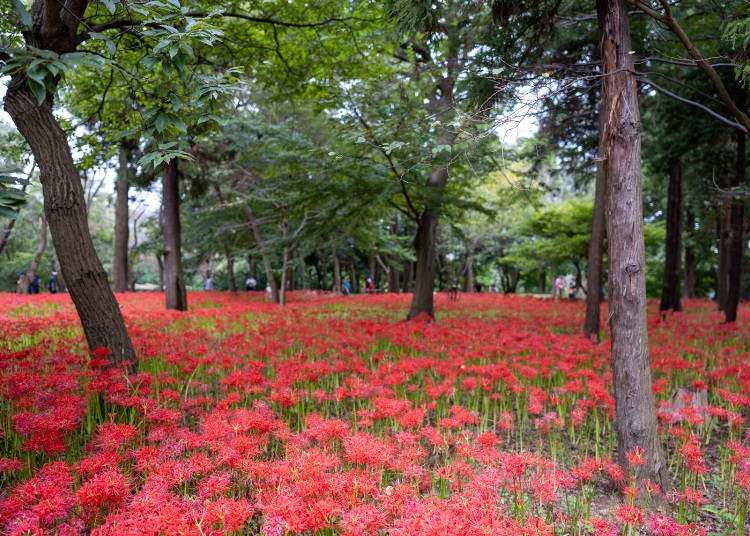
Murakami Green Space Park in Yachiyo City, Chiba, is a favorite local retreat surrounded by nature, and in autumn it’s especially famous for its red spider lilies (manjushage). Thanks to the efforts of local volunteers, about 250,000 bulbs now cover the park’s central slopes, turning them into a brilliant crimson carpet that’s truly breathtaking. To celebrate the bloom, the Yachiyo Red Spider Lily Festival takes place from September 20 to 28, 2025. Visitors can stroll through the dreamlike fields, which are somewhat lesser-known than other areas around Tokyo. Food trucks will be available during the festival period.
-
Murakami Green Space Park村上緑地公園
- Address 901-2 Murakami, Yachiyo City, Chiba 276-0028
-
Nearest Station
From Katsutadai Station (Toyo Rapid Railway/Keisei Line), take the bus bound for Murakami Danchi and get off at Murakami Danchi Daiichi stop.
Alternatively, it’s an 18-minute walk from Murakami Station on the Toyo Rapid Railway Line.
*The best time to see the autumn leaves may change depending on weather and climate conditions.
*Prices and options mentioned are subject to change.
*Unless stated otherwise, all prices include tax.
Popular Tours & Activitiess
Recommended places for you
-
Ad
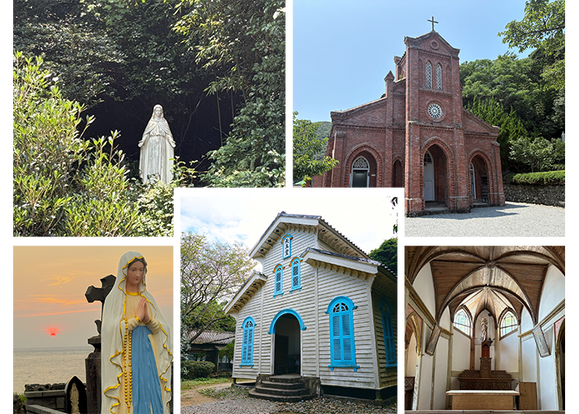
Unraveling the History of the Hidden Christians from Goto Islands, Nagasaki Prefecture, located in Kyushu
by: Yohei Kato
-

The Ultimate Guide to Mitsui Outlet Parks in Japan (2025 Edition) - Popular Tax-Free Malls & Coupon Info for Travelers
-
Ad
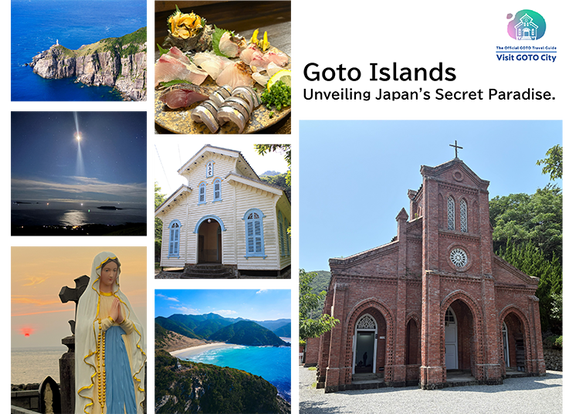
Walk in the Footsteps of Believers: A 4-Day Pilgrimage Across Goto Islands, Nagasaki Prefecture
by: Yohei Kato
-

Black Friday 2025: These Are THE Japan Travel & Shopping Deals to Check Out
-

LaLaport TOKYO-BAY North Building Now Open: Shop, Dine & Enjoy Events at LaLa arena, Just 2 Stops from Disney
by: Wemmy Chau
-

See Asakusa and Tokyo Skytree® in a New Light at the "Také Akari" Festival (Winter 2025-2026)
by: Guest Contributor
Inspiration for Accommodations
-

Enjoy Mt. Fuji from the Comfort of Your Room! Recommended Ryokan with Mt. Fuji View
-

Stay Near the Cherry Blossoms! Hotels for Cherry Blossom Viewing in Tokyo
-

Family-Friendly Hotels with Free Shuttle to Disneyland: Convenient Access for a Magical Stay
-
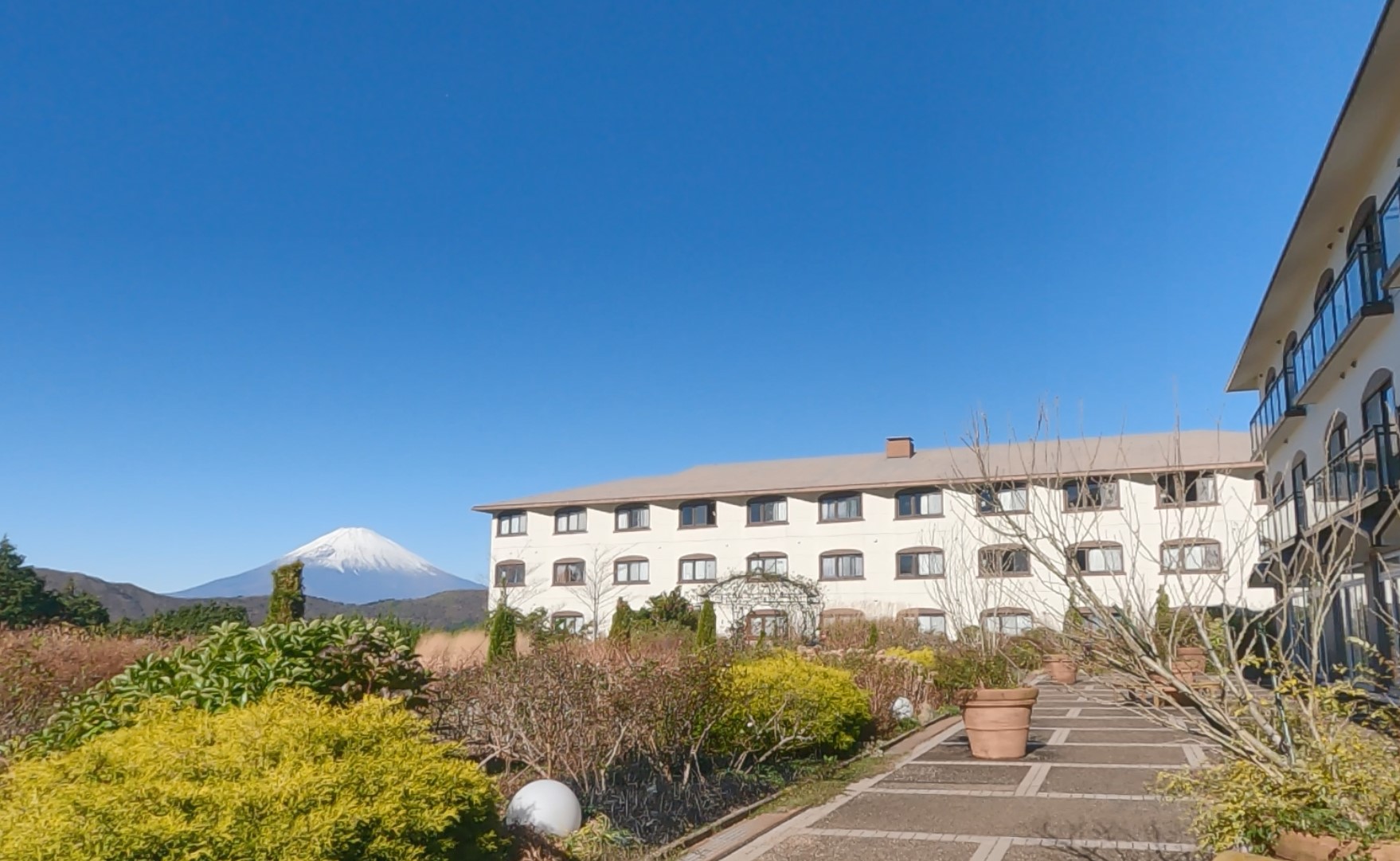
Top Ranked Hakone Hotels with Mt. Fuji View: Enjoy Stunning Scenery from Your Private Space
-
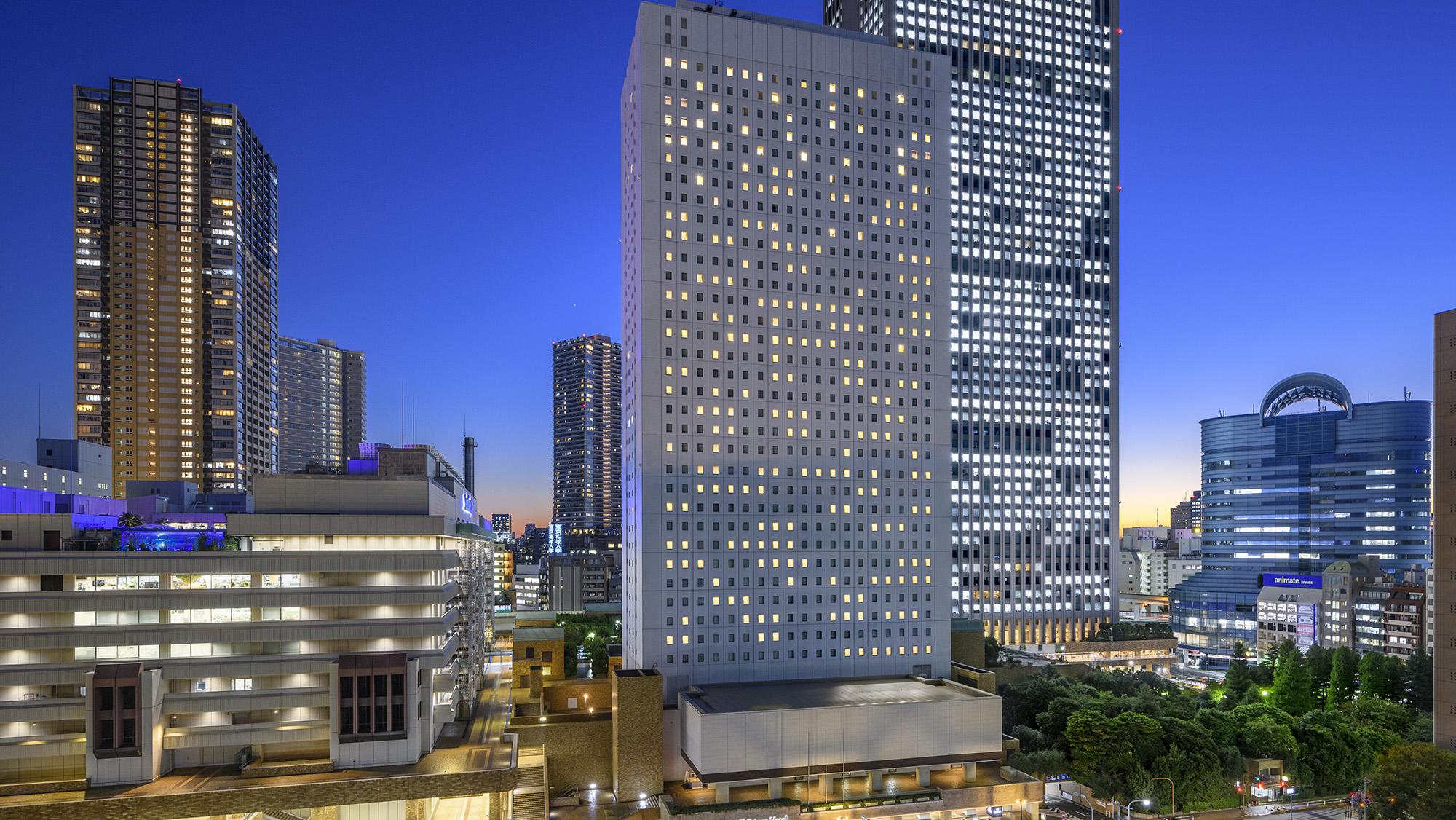
Convenient Tokyo Hotels with Airport Shuttle: Ideal for Families and Heavy Luggage
-

Stunning Tokyo Tower View Hotels: Enjoy Spectacular Scenery from Your Private Space
-

Convenient Asakusa Hotels with Kitchens: Ideal for Extended Family Visits
-

Experience Luxury: Hakone's 10 Best Five-Star Accommodations
-

Enjoy Mt. Fuji Autumn Leaves! Top Hotels Near the Popular Autumn Leaves Corridor
-

Experience Hakone Fall Foliage from Your Room with Stunning Views
-

6 Surprisingly Cheap Things in Japan
-

Enjoy Halloween in Japan 2025: Shibuya & Shinjuku Restrictions and Must-See Events Nationwide
by: Guest Contributor
-

Tips & Advice for Planning a Trip to Tokyo in Autumn
-

Autumn in Tokyo 2025: 16 Best Places to See Fall Foliage in Tokyo
by: Guest Contributor
-

Ikebukuro Station Area Guide: Top 15 Spots When You Escape the Station's Maze!
-

Tori-no-Ichi Fair 2025: Complete Guide to Asakusa's Amazing Festival (Nov 12 & 24)
by: Timothy Sullivan
- #best ramen tokyo
- #what to buy in ameyoko
- #what to bring to japan
- #new years in tokyo
- #best izakaya shinjuku
- #things to do tokyo
- #japanese nail trends
- #what to do in odaiba
- #onsen tattoo friendly tokyo
- #daiso
- #best sushi ginza
- #japanese convenience store snacks
- #best yakiniku shibuya
- #japanese fashion culture
- #best japanese soft drinks


























